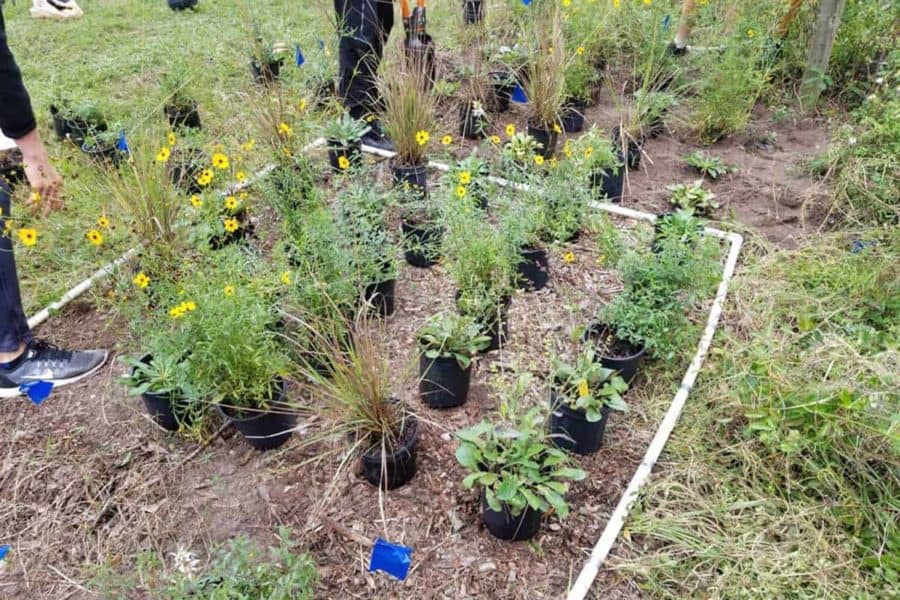Whether you’re searching for an educational activity to do with your children or spending time landscaping while social distancing, UCF’s new Lawn to Wildflowers program out of the College of Sciences can offer a bit of inspiration.
The project, spearheaded by UCF associate professor of biology Barbara Sharanowski and postdoctoral fellow Nash Turley, offers a step-by-step guide on how to turn your lawn into a wildflower garden.
“Anyone with a lawn can do this, regardless of experience level,” Turley says. “We wanted to offer a platform to find everything you need without it being overwhelming. We simplified the site preparation process to three options and from there we offer step by step protocol as well as a selection of plants to choose from that will work best in your region.”
“We wanted to offer a platform to find everything you need without it being overwhelming.”
The program’s website and app, which launched this week, offers guidance for every region in the continental United States and southern Canada. The Lawn to Wildflowers app is free, can be downloaded on iOS and Android mobile devices and is available in the Apple and Google Play app stores.
Turley says the upkeep of a native wildflower garden could be less taxing than maintaining a well-manicured lawn, which call for frequent mowing, water, fertilizers and pesticides.
In addition to offering the basics about wildflower gardens, the app also features a game that teaches how to distinguish between different pollinator groups, such as honey bees, bumble bees, wasps, flies, beetles and butterflies.
Although the game is not mandatory to access the other information, those who advance through all its levels will unlock a special feature: the ability to collect and report data in the app.
“We want to build people up to the point where they can become amateur biologists and collect public science data,” Turley says. “If thousands of people download this app and are reporting, we’ll be able to see which regions have the most groups of pollinators.”
Importance of Pollinators
One of the biggest threats to pollinators is loss of habitat. Pollinators are important because they play critical roles in nature and many of our favorite foods would not exist without them.
According to pollinator.org, which is promoted by the U.S. Fish and Wildlife Service, “pollinators provide pollination services to over 180,000 different plant species and more than 1,200 crops.” Without pollinators, we’d miss out on foods like mango, avocado, watermelon, kiwi, apples, peaches, cashews and chocolate.
Moreover, the U.S. Forest Service adds, “flowering plants produce breathable oxygen by utilizing the carbon dioxide produced by plants and animals as they respire. … Without pollinators, existing populations of plants would decline.”
As a byproduct, Turley also hopes that the Lawn to Wildflowers project will promote a greater appreciation of nature.
“UCF retired Professor Reed Noss wrote in his book Forgotten Grasslands of the South: ‘Endless fascination with nature—nothing more and nothing less—is the key to enlisting people in the fight to save biodiversity,’” Turley says. “People are not super likely to care about a lot of environmental issues unless they have some first-hand experience with them. My hope is that those who download the app and build their wildflower gardens will learn to have an even greater appreciation of nature.”
Turley’s Advice on How to Turn Your Lawn Into a Wildflower Garden
Start small. Focus on a 6-by-6-foot plot, which will help you from getting overwhelmed.
Location, location, location. Select a location that receives a lot of sun, which will help the wildflowers grow. You should also pay attention to the type of soil you’re working with – if it’s sandy, you’ll likely have to water your plants to get them established.
Go native. The idea is to pick plants that are native to your region. Turley recommends incorporating between five to 10 species in your plot. He says for better success on a smaller scale, consider purchasing potted plants from a nursery, which you can transplant into the ground, instead of seeds.
Mix it up. Turley says the ideal pollinator garden has a variety of species of different sizes, flower types and blooming times throughout the year. He also says to consider if the plant fits your needs. “It’s your plot, so you want to like it, too. You should be selecting plants that you’re interested and excited about.”

